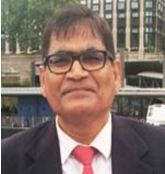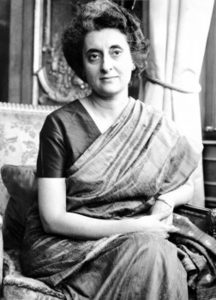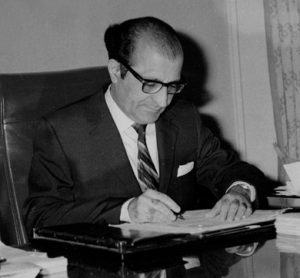 By Professor Satya Narayan Misra in Bhubaneswar, Januray 24, 2022: Vice President Jagdeep Dhankar recently dropped a bombshell by observing that the basic structure doctrine espoused in Keshavanand Bharati Case in 1973 has set a wrong precedent. While addressing the 83rd All India Presiding Officers, the VP observed that parliamentary supremacy is ‘quintessential for the survival of democracy, it can’t be permitted to be compromised by the judiciary’.
By Professor Satya Narayan Misra in Bhubaneswar, Januray 24, 2022: Vice President Jagdeep Dhankar recently dropped a bombshell by observing that the basic structure doctrine espoused in Keshavanand Bharati Case in 1973 has set a wrong precedent. While addressing the 83rd All India Presiding Officers, the VP observed that parliamentary supremacy is ‘quintessential for the survival of democracy, it can’t be permitted to be compromised by the judiciary’.
His remarks bring back memories of Nani Palkhiwala, one of the greatest lawyers that India has produced, to bring up the basic structure doctrine before a full bench of the Supreme Court in the sweltering summer of 1973.
In the iconic Keshavanda Bharati case seven judges chimed in with the government that it can amend any article by complying with the procedure underlined in Art 368 of the Constitution but cannot alter the basic structure or foundation of the Constitution. While no composite list was provided there were a few features that had a general consensus viz, Sovereignty, Democracy, Republic, Secularism, Federalism, Separation of Powers, free & fair election & judicial independence /review.
While many credits this doctrine to the legendary lawyer Nani Palkhiwala who argued against the 24th Amendment, the intellectual underpinning was provided by the German jurist Dietrich Conrad. While delivering an address in Benares Hindu University in 1965, Prof Conrad recounted how Hitler after becoming Chancellor of Germany in 1933 suspended the constitutional provisions by curtailing civil rights and committing mass Human rights violations. Mere procedural limits (2/3rd majority of members of the Parliament) were not sufficient safeguards against inviolable principles of the Constitution.
When FRG drafted its new Constitution, it specified certain parts like federalism, democracy, and rule of law, separation of powers which cannot be modified. This established Conrad’s seminal principle of implied limitation of the amending power. To quote Prof Conrad ‘An amending body, however, powerful cannot change the very structure that supports its constitution’.
Nanabhoy cited Conrad who argued for implied limitation on Parliament’s amending power, which was upheld by the seven judges of the full bench. Mrs. Gandhi was understandably chagrined by such limitation put forth by the Court and superseded three senior judges to appoint AN Roy as the CJI on 25 th April 1973. The buzzword word was ‘committed judiciary’, wedded to the philosophy of the party in power.
 She fired the second salvo by bringing in the 39th amendment (1975); Art 329A, which ring faced any challenge to the election of President, VP, PM & Speaker from judicial review. In a unanimous verdict which included CJI Roy, the Supreme Court struck down the39 th amendment by reiterating that judicial review is a basic feature ‘in the matter of election to ensure free, fair & pure election. ‘The judgment was also a vindication of another basic structure viz ‘rule of law’ where the PM is equal in the eyes of law with other elected representatives.
She fired the second salvo by bringing in the 39th amendment (1975); Art 329A, which ring faced any challenge to the election of President, VP, PM & Speaker from judicial review. In a unanimous verdict which included CJI Roy, the Supreme Court struck down the39 th amendment by reiterating that judicial review is a basic feature ‘in the matter of election to ensure free, fair & pure election. ‘The judgment was also a vindication of another basic structure viz ‘rule of law’ where the PM is equal in the eyes of law with other elected representatives.
Stung by this judgment, the then CJI AN Roy at the prompting of the government asked the full bench to review the basic structure doctrine de no vo. Nani Palkhiwala led the charge against such an egregious move on 10th & 11th November 1975. By 12 th November, the CJI was reduced to one and dissolved the bench constituted. It was a sterling performance and Justice HR Khanna later observed: ‘It was divinity speaking through Nani. The heights of eloquence were unparalleled.’
Mrs Gandhi was undeterred and amended Article 368 to bring in two new subclauses (4) & (5) through the 42nd amendment in 1976 which gave Parliament plenary power to amend the Constitution and took the right of the Supreme Court to review them. The case was again forcefully argued by Nani Palkhiwala. In a landmark judgment (4-1) CJI YV Chandrachud wrote ‘since the Constitution had conferred a limited amending power on the Parliament, the Parliament cannot enlarge that very power into an absolute power.’
It was a clear reiteration of Conrad’s implied limitation theory. The Minerva Mills case (1980) is widely regarded as the last nail in the ruling party’s will to be absolutist & circumvent legal challenges. The hallowed concepts of the basic structure have struck grudging conformance of all ruling parties. The Modi government breathed a sigh of relief when its 103rd amendment to bring in 10% reservation to EWS was not considered an affront to the basic structure principle and was upheld.
 Coincidentally, such discordant noises are being made by the VP when the nation is paying tribute to Nani Palkhiwala on his 93 rd Birth Day. Speaking on the occasion, CJI D Y Chandrachud observed that he stood for personal freedom and gave us the basic structure doctrine. He was also a great votary of free market economics & against the protectionist policy of the government. His budget speech used to be hugely popular.
Coincidentally, such discordant noises are being made by the VP when the nation is paying tribute to Nani Palkhiwala on his 93 rd Birth Day. Speaking on the occasion, CJI D Y Chandrachud observed that he stood for personal freedom and gave us the basic structure doctrine. He was also a great votary of free market economics & against the protectionist policy of the government. His budget speech used to be hugely popular.
Vijay Merchant, the cricketer, used to say that Nani brought in crowds to the Brabourne cricket stadium through his budget speech. It used to be also said that there were two budget speeches, one by the FM on the floor of the Parliament and the other by Palkhiwala in either Brabourne stadium in Bombay or the huge Shanmukhananda hall in Chennai.
It’s sad that such a proud legacy left behind by Nani is being eviscerated through irresponsible observation by the V P Palkhiwala’s fearlessness to confront an authoritarian government, which wanted to snuff out right & liberty during the dark emergency years, for eschewing arbitrary curtailment of freedom & protect the masculine majesty of the Constitution will ever remain an indelible legacy
*Prof Misra teaches Constitutional Law



Leave a Reply
Be the First to Comment!